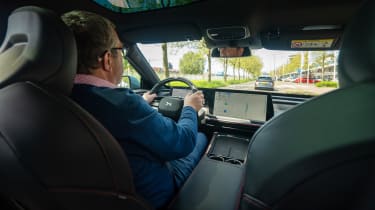New XPeng P7 2023 review
Xpeng’s P7 is another upcoming rival to the Tesla Model 3 and Hyundai Ioniq 6, but it struggles to stand out from an increasingly large crowd
Verdict
The XPeng P7 has the tech and range to compete with Tesla’s Model 3 and the Hyundai Ioniq 6. But it can’t escape its slightly longer storyline when it comes to interior fit and finish, and the packaging isn’t as sharp as that of another likely rival, the BYD Seal. In big-battery, rear-drive form, it’s still a car that would find customers in the UK, if XPeng felt ready to put itself in front of them – but with the market developing so quickly, the scope for it to stand out is narrowing with every month that passes.
For some time, the Tesla Model 3 has been the go-to small electric saloon. But its position is under increasing threat from the likes of the recently launched Hyundai Ioniq 6 and the incoming BYD Seal. And now there’s another newcomer that could well make it to the UK in the next 18 months to two years: the XPeng P7.
Truth be told, the P7 is not a brand new car; it’s a heavily revised model that’s been on sale in selected regions since 2020. But that in itself is another marker for a pretty astonishing start-up brand; founded less than 10 years ago, XPeng only put its first car into production in 2018, yet it has medium-term plans to have capacity for up to 800,000 cars per year, and it is stretching its reach into more and more areas of Europe. Norway, Denmark, Sweden and the Netherlands are up and running; Belgium and Luxembourg will follow, with Germany a likely candidate for 2024. A decision has yet to be made on making right-hand-drive cars for the UK but it’s “under consideration”. Think late 2024 or early 2025, we’d say.
Used - available now

2023 Tesla
Model 3
20,844 milesAutomaticElectric
Cash £22,200
2020 Hyundai
Kona Electric
47,452 milesAutomaticElectric
Cash £13,600
2022 Mercedes
GLC
35,715 milesAutomaticDiesel2.0L
Cash £30,587
2025 Audi
A4 Avant
33,571 milesAutomaticPetrol2.0L
Cash £24,787That should be just about enough time for the P7 to play a part in any UK rollout, which is why we’re in Amsterdam to drive it for the first time. It’s a fairly anonymous-looking creation – swoopy, undoubtedly, but perhaps a little soft in character, with the exception of the sharp ‘X robot face’ front end. It’s does a good job of disguising its considerable length, though; at almost 4.9 metres, it’s a bit longer than an Ioniq 6 and quite a bit longer than a Model 3.
In principle at least, the P7 shares its underpinnings with XPeng’s other recent launch, the G9 SUV. But it sticks with 400-volt electrics instead of the taller model’s fancier 800V set-up, and that limits its maximum charging speed to 175kW. That’s a far-from-disgraceful figure and in any case, the single battery option – an NMC-chemistry pack with a usable 82.7kWh – promises decent range, particularly in the single-motor, entry-level version that we’re trying today.
The edition in question is actually called the RWD Long Range and it has 272bhp and 440Nm of torque, for a 0-62mph time of 6.7 seconds and a whopping WLTP range of 358 miles.
There are also two dual-motor versions – one with regular doors, the ‘Wing Edition’ with supercar-esque scissor front doors. These models have identical powertrains pumping out a combined 467bhp and 757Nm, delivering 0-62mph in a far more Tesla-esque 4.1 seconds. But the range falls, to 314 miles.
A mere 272bhp may not sound a great deal to shift a car that weighs a whisker over two tonnes, but instant electric-motor torque helps the P7 to feel brisk enough. XPeng’s engineers have done a decent job on input modulations, too, so it’s pretty easy to drive the car smoothly when accelerating and braking – not a given in many Chinese EVs.
The P7 definitely feels more sporty and agile than its G9 cousin – helped by solid body control and well-weighted, direct steering. It’s not as sophisticated as, say, a BMW i4, but it will allow you to lean on it through corners, while ironing out most road imperfections. The ride of the entry-level P7 on regular springs and dampers isn’t as sophisticated as in the G9 with air suspension, and there’s definitely a bit more patter, along with an audible low-frequency rumble at higher speeds – but then, there is a 20-grand price gap between the two models.
The saloon’s range is for real, too. On a warm spring afternoon in Amsterdam, on a mix of traffic-clogged streets, fast motorways and quiet back roads, and with no conscious effort in the name of efficiency, the P7 managed over four miles per kWh. That equates to a total range impressively close to its WLTP figure.
XPeng is trying to sell its cars with minimal scope for options, and that means a generous list of standard equipment. Every P7, regardless of powertrain, gets a heat pump as standard, along with a full onslaught of in-car tech that includes a crisp 10.25-inch digital instrument panel and a responsive 14.96-inch central infotainment screen. A few too many of the car’s features are more than one click from the home screen for our liking, but XPeng has at least done the decent thing and included proper switches on the steering wheel and screen shortcuts to key functions.
One of the more disappointing aspects of the P7 is its practicality. There’s decent legroom in the rear but headroom is tight for taller passengers, and while the boot capacity is a decent 440 litres, there’s no hatchback flexibility and the opening itself looks relatively tight. You’ll have to store your cables on the boot floor too, since the aforementioned heat pump means no space for an under-bonnet ‘frunk’.
The other area where the car may struggle is its finish and materials, which definitely feel a little behind those of the (admittedly more expensive) G9. In this respect, the P7 betrays its relative age in a fast-developing market; it’s neat enough, but there are still a few too many slabs of black plastic where rivals, such as the Ioniq 6, now have more pleasing metallic finishes or even fabrics.
| Model: | XPeng P7 RWD Long Range |
| Price: | €49,990 (£43,400) (Netherlands) |
| Powertrain: | 1x e-motor, 82.7kWh batt. (net) |
| Power/torque: | 272bhp/440Nm |
| Transmission: | Single-speed automatic, rear-wheel drive |
| 0-62mph: | 6.7 seconds |
| Top speed: | 124mph |
| Range: | 358 miles |
| Max charging: | 175kW (10-80% in 29min) |
| On sale: | 2025 (est.) |
Now read our review of the BYD Seal...











